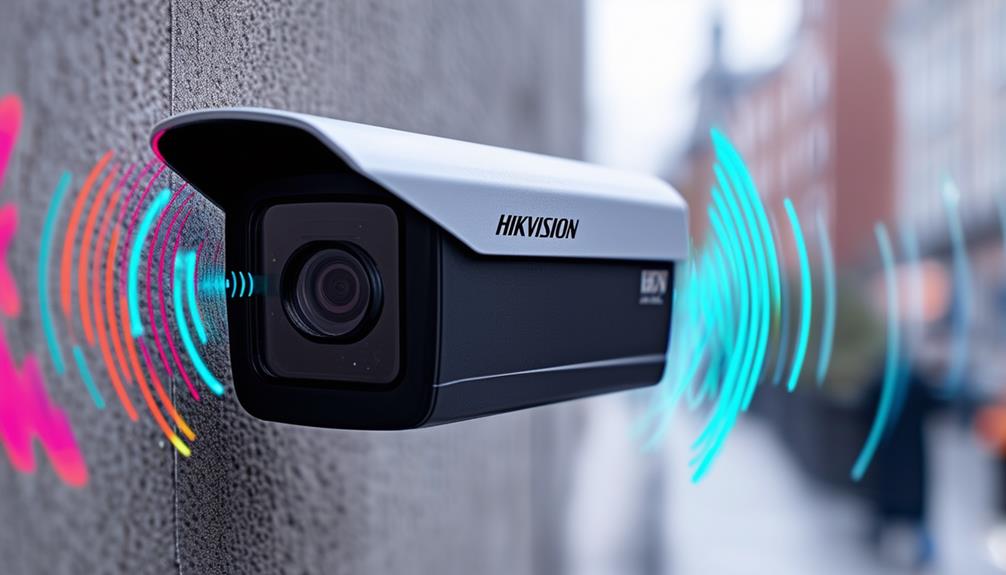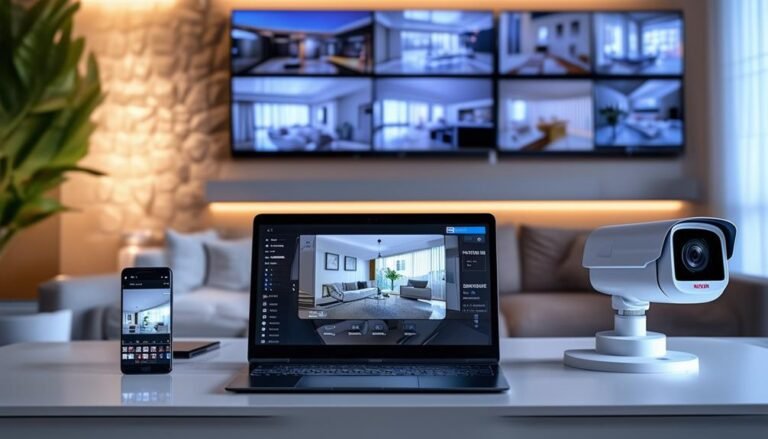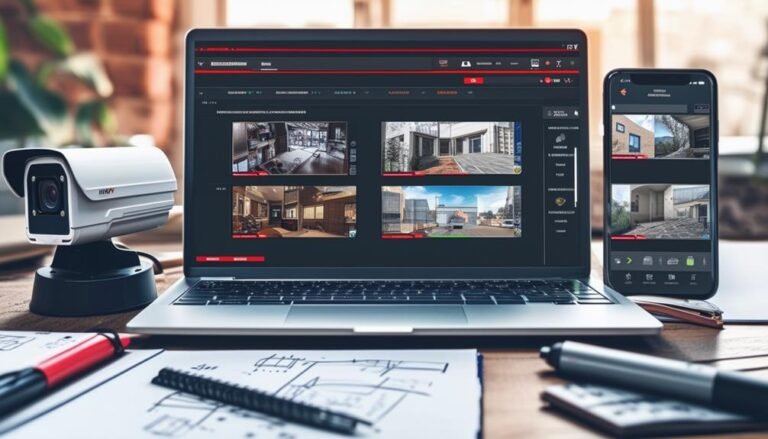Yes, Hikvision cameras can record audio, adding a significant layer to your surveillance systems. Many models come with built-in microphones or options for external audio devices, so you can capture sound along with high-definition video. This feature is especially useful in environments where conversations occur, like stores or public areas. However, make sure you're aware of the local laws regarding audio recording, as they differ by location. Setting up and configuring these audio features is essential for effective monitoring. Stick around, and you'll discover more about maximizing your Hikvision camera's capabilities.
Overview of Hikvision Cameras
When it comes to surveillance technology, Hikvision cameras stand out for their advanced features and reliability. You'll find a diverse range of models designed to meet various security needs, from homes to businesses. These cameras incorporate cutting-edge technology, ensuring that you have a clear view of your surroundings, day or night. The high-definition video quality helps you capture every detail, giving you peace of mind knowing that you're well-protected.
One of the key strengths of Hikvision cameras is their versatility. Whether you need a dome camera for discreet monitoring or a bullet camera for long-range visibility, there's a model that fits your specific requirements. You can even find options that support pan-tilt-zoom (PTZ) capabilities, allowing you to cover larger areas with just one device.
Additionally, Hikvision's user-friendly interface makes it easy for you to set up and manage your cameras. You can easily access live feeds or recorded footage from your smartphone or computer, ensuring you're always in the loop. The integration with smart home systems gives you the freedom to customize alerts and notifications according to your preferences.
With options for both wired and wireless connections, you can choose the setup that best suits your environment. As you explore Hikvision cameras, you'll appreciate how they empower you to take control of your security. In a world where personal freedom is paramount, having reliable surveillance technology helps you safeguard your space while maintaining your independence.
Audio Recording Capabilities
Hikvision cameras not only excel in video surveillance but also offer impressive audio recording capabilities. If you're looking to enhance your security setup, these cameras can be a game-changer. With built-in microphones or the option to connect external audio devices, you can capture sound alongside high-definition video. This dual functionality allows you to monitor not just what's happening visually but also the conversations and sounds that accompany those visuals.
Imagine being able to hear a conversation that could provide vital context to an event you're recording. Whether it's a business environment or your home, having audio adds an extra layer of security and awareness. You can easily review footage with both audio and video, giving you an extensive understanding of any situation.
Moreover, the ability to record audio can help deter unwanted behavior. When people know they're being recorded, both visually and audibly, it can encourage them to think twice before engaging in misconduct. This capability is especially useful in areas where verbal interactions are common, such as retail stores or public spaces.
It's important to remember, though, that recording audio may come with legal considerations depending on your location. Always check your local laws to verify you're compliant when using audio recording features. With Hikvision, you're not just investing in surveillance; you're gaining the power to monitor your environment more effectively and freely.
Types of Audio Inputs
When it comes to recording audio with Hikvision cameras, you'll find a variety of microphone options available to fit your needs. Understanding the different audio input interfaces and their compatibility with devices is essential for getting the best performance. Let's explore how these factors can enhance your audio recording experience.
Microphone Options Available
Exploring microphone options available for Hikvision cameras reveals a variety of audio input types that cater to different surveillance needs. This flexibility allows you to tailor your audio recording capabilities to your specific environment, ensuring you capture the sounds that matter most.
Here are three popular microphone options you might consider:
- External Microphones: These can be strategically placed to enhance audio quality, allowing for clearer sound pickup. They come in various styles, including shotgun and omnidirectional, depending on your needs.
- Built-in Microphones: Many Hikvision cameras come with built-in microphones, making installation and setup straightforward. They're perfect for general surveillance, capturing ambient sounds without needing extra equipment.
- Wireless Microphones: Offering greater freedom in placement, these mics can be positioned away from the camera, reducing clutter and allowing for discreet audio collection.
Audio Input Interfaces
Choosing the right microphone is just the beginning; understanding the audio input interfaces available for Hikvision cameras is equally important. You'll find different types of audio inputs that can enhance your recording experience. Most Hikvision cameras come equipped with a 3.5mm audio input, which is versatile and can accommodate various microphones. This standard connection allows for easy integration with many external microphones, giving you flexibility in your audio capture.
If you're looking for something more advanced, consider cameras that support Line-In and Microphone-In options. Line-In is ideal for professional setups, allowing you to connect to mixers or other audio devices, while Microphone-In is tailored for direct microphone connections.
Additionally, some cameras come with built-in PoE (Power over Ethernet) capabilities, making it easier to power devices while transmitting audio. Remember, the choice of audio input interface can greatly impact the quality and clarity of your recordings. So, take time to evaluate your needs and choose the right setup that aligns with your vision for audio capture. The freedom to customize your audio experience is at your fingertips!
Compatibility With Devices
Compatibility with various devices is essential for maximizing the potential of your Hikvision camera's audio capabilities. When you're looking to enhance your surveillance experience, understanding the types of audio inputs your camera can work with is vital. You want the freedom to integrate your camera seamlessly into your existing setup. Here are three common audio input types to take into account:
- Microphone Inputs: Choose between built-in microphones or external ones. External microphones often provide superior sound quality and flexibility in placement.
- Line Inputs: These inputs allow you to connect various audio sources, like mixers or other audio devices, ensuring you capture the desired sound environment.
- IP Audio Devices: With advancements in technology, many Hikvision cameras can interface with IP audio devices, enabling wireless audio capture and control from anywhere.
Legal Considerations for Audio Recording
When it comes to recording audio with Hikvision cameras, understanding the legal landscape is essential. You've got to be aware of the laws governing audio recording in your area, as they can vary remarkably. In many jurisdictions, recording audio without consent may infringe on privacy rights, leading to potential legal consequences.
To help you navigate these considerations, here's a quick reference table summarizing key points:
| Aspect | One-Party Consent | Two-Party Consent | No Consent Required |
|---|---|---|---|
| Definition | Only one party needs to consent to the recording. | All parties involved must consent. | No consent needed for recording. |
| Common Jurisdictions | Many U.S. states, e.g., New York | California, Florida | Some states, e.g., Texas |
| Implications | Easier for personal use; less risk of legal issues. | Requires clear communication; higher risk of legal disputes. | Generally safer for public spaces, but check local laws. |
| Use Cases | Private conversations, internal meetings. | Interviews, sensitive discussions. | Public events, street monitoring. |
| Recommended Action | Always inform parties when possible. | Get explicit consent in writing. | Review local laws before proceeding. |
Before you hit record, make sure you've done your homework. It's vital to respect the privacy of those around you. By staying informed and compliant with local laws, you can enjoy the benefits of audio recording while minimizing legal risks. Remember, freedom comes with responsibility!
Setting Up Audio Features
When setting up the audio features on your Hikvision camera, you'll want to explore the various audio input options available. Configuring the audio settings correctly is essential for ideal performance, but don't forget to keep legal considerations in mind. Let's take a closer look at how to get everything set up properly.
Audio Input Options
To enhance your Hikvision camera's functionality, setting up audio features is essential. You'll want to explore the various audio input options available to you, as these can greatly elevate your surveillance experience. Here are three key audio input options to evaluate:
- External Microphone: Connect an external microphone to capture clear audio from a distance, allowing you to monitor conversations or sounds outside your camera's immediate vicinity.
- Built-in Microphone: Some Hikvision cameras come equipped with a built-in microphone. This option is perfect for quick setups, as it requires minimal effort while still providing decent audio quality for nearby sounds.
- Network Audio Interface: If you're looking for more advanced capabilities, think about using a network audio interface. This option lets you integrate multiple microphones into your system, giving you the freedom to cover larger areas and improve audio capture.
Configuring Audio Settings
Configuring audio settings on your Hikvision camera is essential for optimizing your surveillance system's performance. To get started, access the camera's web interface or mobile app. Navigate to the audio settings section, where you'll find options to enable or disable audio recording.
You'll want to select the appropriate audio input source, whether it's an external microphone or the built-in mic. Adjust the audio gain to guarantee clarity without distortion. Remember, if you have multiple cameras, you may need to configure audio settings for each one individually.
Don't forget to test the audio after configuration. Speak near the camera while monitoring the live feed to check the audio quality. If it's too faint or overly loud, go back and tweak the gain settings.
Lastly, consider setting up notifications that alert you when the audio is triggered by sound, like breaking glass or unexpected voices. These features help you maintain a secure environment and stay informed. With everything set up, you can enjoy the peace of mind that comes from knowing your surveillance system is capturing both video and audio effectively.
Legal Considerations for Audio
Understanding the legal considerations surrounding audio recording is vital for any user of Hikvision cameras. Ignoring these laws could lead to serious consequences, so you'll want to be informed before setting up audio features. Here are three key points to keep in mind:
- Consent: In many jurisdictions, you need to get consent from individuals before recording their voices. This could mean placing clear signage or notifying people in advance.
- Privacy Laws: Be aware that privacy laws vary by location. Some areas have strict regulations on audio recording, especially in private spaces. Familiarizing yourself with local laws is important.
- Purpose of Recording: Always have a legitimate reason for recording audio. Whether it's for security, monitoring, or other purposes, confirm that your intent aligns with legal standards.
Benefits of Audio Surveillance
Audio surveillance offers significant advantages that can improve security and situational awareness in various settings. First and foremost, it provides an additional layer of information that visual surveillance alone can't capture. When you can hear conversations or ambient sounds, you're better equipped to assess situations accurately. This can be particularly useful in environments where verbal communication is critical, like retail stores or office spaces.
Moreover, audio surveillance can deter potential trespassers or criminals. Just the presence of microphones can make individuals think twice before engaging in illicit behavior, knowing they could be recorded. This acts as a proactive measure to safeguard your property and maintain a secure environment.
In emergency situations, audio recordings can be invaluable. They can provide real-time context during an incident, helping law enforcement or security personnel respond more effectively. This not only aids in resolving immediate threats but can also serve as evidence in investigations.
Furthermore, integrating audio with video surveillance allows for a more thorough understanding of events. You get a fuller picture of what's happening, enabling you to make more informed decisions.
Lastly, audio surveillance can enhance communication in various settings. For instance, in workplaces, it can facilitate better collaboration and guarantee that important discussions are documented. You're not just relying on visuals; you've got the context that sound provides.
In a world where security and awareness are paramount, the benefits of audio surveillance shouldn't be overlooked. It's a tool that empowers you to protect your space more effectively.
Troubleshooting Audio Issues
While the benefits of audio surveillance are clear, it's not uncommon to encounter audio issues that can hinder performance. If you find yourself facing these challenges, don't worry; troubleshooting is often straightforward. Here are a few steps you can take to regain control over your audio surveillance.
- Check Your Connections: Verify all cables are securely connected. Loose or damaged cables can result in poor audio quality or complete loss of sound. Wiggle those connections and see if that resolves the issue.
- Adjust Sensitivity Settings: Sometimes, the microphone sensitivity settings may be too low or too high. Access your camera's settings and make adjustments as needed. Finding that sweet spot can greatly enhance your audio clarity.
- Inspect for Interference: External factors can affect audio performance. Check for potential sources of interference, like nearby electronic devices or considerable background noise. Reducing these distractions can greatly improve your audio capture.
If after trying these steps you're still struggling, consider reaching out to Hikvision's support or consulting the user manual. Remember, the freedom to monitor your surroundings effectively is essential, and addressing audio issues can help you achieve that goal. Don't let these hurdles hold you back—take charge and resolve the problem!
Frequently Asked Questions
Do Hikvision Cameras Support Two-Way Audio Communication?
Imagine sitting at a café, chatting freely with friends, while a camera captures every moment. Just like that, Hikvision cameras can support two-way audio communication, letting you speak and listen in real-time. This feature's perfect for keeping an eye on loved ones or communicating with visitors at your door. You don't have to miss a beat; you can connect effortlessly, ensuring you stay in control of your environment, wherever you are.
Can I Connect External Microphones to Hikvision Cameras?
You can connect external microphones to Hikvision cameras, enhancing your audio capabilities. It gives you the freedom to capture clearer sound from different sources. Just verify the microphone is compatible with your camera's input options. Many users appreciate this flexibility, especially in surveillance situations where audio plays an essential role. By selecting the right microphone, you can markedly improve your overall recording experience and gain more control over your audio environment.
Are There Any Hikvision Models Without Audio Recording Features?
You might be surprised to learn that around 30% of surveillance cameras on the market don't have audio recording features. If you're looking for Hikvision models without this capability, you're in luck—there are several options available. Many of their cameras focus solely on video surveillance, allowing you to maintain privacy while still keeping an eye on your property. So, you can choose models that fit your specific needs without worrying about audio recording.
How Long Can Hikvision Cameras Store Audio Recordings?
When it comes to storing audio recordings, it really depends on your camera's settings and storage capacity. Typically, Hikvision cameras can retain recordings for a few days to several weeks, depending on the storage space you've allocated. If you're looking for longer retention, consider expanding your storage options or adjusting the recording settings. Just remember, keeping audio recordings for extended periods might raise privacy concerns, so always be mindful of the implications.
Can Audio Recordings Be Accessed Remotely?
Imagine having the power to check in on your space from anywhere, like a hawk soaring overhead. Yes, you can access audio recordings remotely, as long as your Hikvision system is set up correctly. Whether you're at home or miles away, you'll have the freedom to listen in, ensuring you stay connected to what matters. Just make sure you've got the right permissions and network setup to make it all happen!



